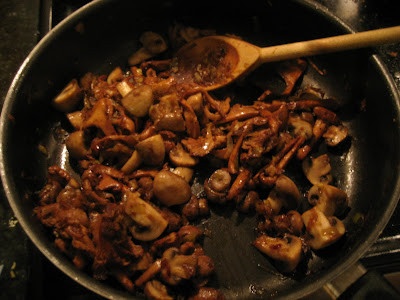The blog has been in a bit of a slump as of late. Hopefully this menu will inspire some culinary adventures during the upcoming holiday.
I guess the theme of the dinner was extending relatively familiar techniques into new territory. And making this onion tart, which I've wanted to try since I got Simon Hopkinson's Roast Chicken and Other Stories last year. I figured as long as I was starting with a tart, I might as well end with one. So there are the bookends. As for the gnocchi, I thought it was time to try a complete dish with them after my experiment a couple weeks ago. For the ragu, I wanted to use a protein that I hadn't cooked before. The beef shank was cheap and delicious, and for sale at the butcher around the corner. I would probably cook it even longer than 4 hours next time, but the slightly chewy texture was nice enough. I chose to serve it with orechiette (partially inspired by a recent dinner at Roberta's in Brooklyn) which I've never made before, but like a lot. Et voila.
Onion Tart
The recipe for this tart, which came directly from Roast Chicken is conveniently posted online here. Unfortunately the units are all metric. 110 g of flour is one cup. The butter quantities translate to 4 tablespoons (1/2 stick) for the pastry and the same for the filling. Despite Simon's assurances that four onions, which produce an alarmingly large number of slices (and tears), is the right quantity, I ended up using just three. I reduced the corresponding amounts of cream (1 cup -> 3/4 cup) and egg yolk for the filling, though not the butter. As you can see, the tin was completely filled anyway.
This tart is delicious. The caramelized onions are really sweet, and the custard and crust are decadent without overwhelming the onion flavor. I will definitely make this again, but in the future I would serve it with some simply dressed greens. I think the added bitterness and acidity, though not strictly necessary, would make this even tastier.
Main Courses
As you can see, we made a lot of gnocchi and pasta, almost all of it gone by the end of the evening.
Gnocchi
I made the gnocchi in same way as in my earlier post.
Initially, I wasn't quite sure what I would do with them. I was thinking of a gorgonzola and mushroom cream sauce. But there was no gorgonzola anywhere we shopped. The chanterelles that they had at Costco ended up deciding my course. Although a bit suspect at almost two weeks old, I figured I would give them a chance for nine bucks a pound. In the end, I think they were worth it, but they could easily have been disgusting if not handled properly. The dish was rounded out with another pound of mushrooms, mostly crimini with a few white mushrooms mixed in, three leeks, some cream, some armagnac and butter.
First, I cleaned the mushrooms, using as little water as possible, particularly for the chanterelles, which were already a bit waterlogged. I ended up discarding several and trimming slimy sections from several more. Put them out to dry for a while after cleaning. I cut the mushrooms into halves and quarters or left them whole depending on their size. Next, I trimmed and cleaned the leeks, discarding of the green section, although my poor quality leeks would have disappeared entirely if I had kept only the white part. I chopped them finely, then stewed them gently in a few tablespoons of butter.
While the leeks were cooking, I threw the chanterelles into a dry pan at medium-high heat. They released a huge quantity of liquid, which I periodically poured into the leeks to simmer off. Without this step I think the chanterelles would have been pretty slimy and gross.

After probably 7-8 minutes of this, the chanterelles were pretty well dried out and I threw them in with the leeks, as well as the rest of the mushrooms and a little more butter. I cranked the heat back up for this stage to brown the mushrooms and added seasoning. Once they were pretty well cooked, I added a splash of cream. Once this had reduced a bit, I poured in about 1/2-3/4 cups of Armagnac, which I then lit on fire. I finished it with a little more cream and then tossed it with the fresh gnocchi. People added parmesan themselves.
Beef Shank Ragu with Orechiette
I made the pasta in the usual way. I think I used four eggs. To make the circles, I used the cap of an olive oil bottle; to make dimples, we just pressed with our fingers, to varying success.
The ragu was made from a little bacon, about a pound of ground pork, onions, carrots, celery, garlic, about two pounds of beef shank, cut in about 1-inch pieces, a bit more than a cup of white wine, some San Marzano tomatoes, a little cream and parsley.


















































